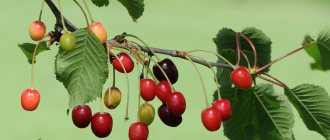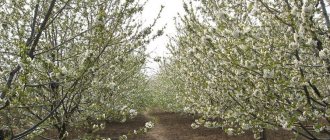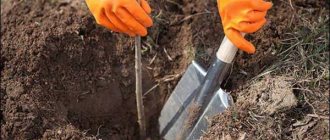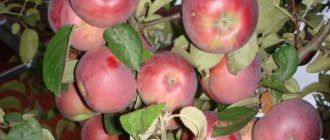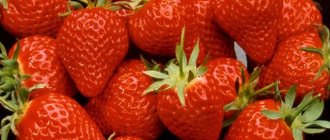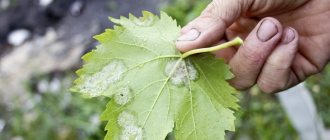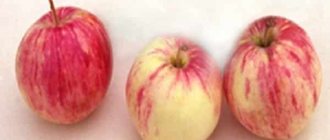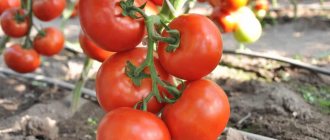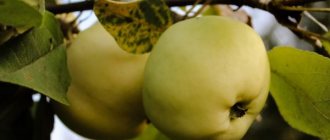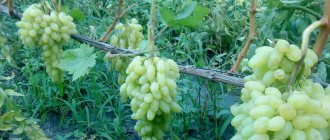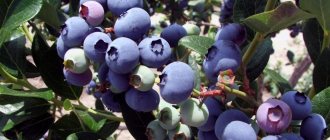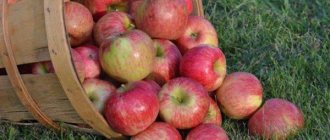Photo and description of the Syubarovskaya cherry variety
Sweet cherry Syubarovskaya was obtained by crossing the Pobeda and Severnaya varieties. It received its name in honor of one of the authors - E. Syubarova. In 2005, the hybrid was included in the state register of the Republic of Belarus.
Mature tree height
The tree is vigorous and fast-growing, reaches a height of 4-5 m. The crown is wide-pyramidal in shape, of medium density. The bark on the trunk and main shoots is smooth and brown in color. The shoots are straight brown-brown. The leaves are large, elongated, ovoid, matte, dark green in color. The leaf plate is boat-shaped with a rounded base, finely serrated edges and a pointed apex. The petioles are thick and short.
Flowering and ripening period
The buds bloom in the mid-late period (mid and late May). The umbrella-shaped inflorescences consist of 2-3 white flowers. The harvest ripens in early July. Fruiting begins 4 years after planting.
Features of the fruits of the Syubarovskaya variety:
- one-dimensional round shape;
- height 1.8 cm, girth 2 cm;
- base with recess;
- the ventral suture is not pronounced;
- dark red skin;
- burgundy juicy pulp;
- The oval bone easily comes away from the pulp.
Pollinators of the Syubarovskaya cherry
The Syubarovskaya cherry is self-fertile; the harvest is formed with the help of pollinators. To set fruit, you need at least 2 varieties blooming at the same time. They are planted at intervals of 3-4 m. If there is no free space on the site, a strong rootstock is chosen: wild or ordinary cherry, antipka. Suitable 2-3 varieties are grafted onto it. Honey plants are planted to attract bees and other insects. Most ovaries form in warm weather, in the absence of extreme heat, temperature changes and rain.
The best pollinators for Syubarovskaya cherries:
- Gronkova. Medium-sized tree with a pyramidal crown. The fruits are heart-shaped, one-dimensional, weighing 4.6 g. The color of the skin and pulp is burgundy. The tasting score is high: 4.8 points. Maturation occurs at an early stage. The variety is resistant to coccomycosis and moniliosis. Fruiting begins in the 4th year. Cherry has a table purpose.
- Northern. Tree with a sparse compact crown. The fruits are obtusely heart-shaped, the main color is whitish and has a pronounced pink blush. The flesh is tender light pink. The weight of the berries is from 3.5 to 4 g. Ripening occurs in medium terms. The variety has increased resistance to frost and is little susceptible to coccomycosis.
- Folk. Belarusian variety of mid-early ripening. It is a medium-sized tree with a wide pyramidal crown. The fruits are one-dimensional, weighing 4 g, the skin and pulp are dark red. Taste rating – 4 points. Winter-hardy variety with increased immunity to coccomycosis. Berries for dessert purposes, suitable for processing.
Productivity
The Syubarovskaya variety brings a stable high yield. Up to 30 kg of fruits are removed from the tree. The berries have a good sweet taste. Tasting score – 4.8 points.
Transportability
The fruits of the Syubarovskaya variety are suitable for transportation. Their purpose is universal: fresh consumption, freezing, processing.
Drought resistance
Drought resistance is average. Young plantings are provided with more frequent watering. Mature trees require moisture according to the standard scheme adopted for this crop.
Frost resistance
The frost resistance of the Syubarovskaya variety is assessed as average. Under shelter and snow cover, the tree can withstand cold winters without problems.
Landing
To plant a young tree, you need to mix two buckets of humus with one bucket of soil. As a top dressing in the spring, 1 kg of wood ash mixed with 400 g of superphosphate is added to the soil. Cherry trees should be planted in early spring, even before buds appear on the seedling. During the digging process, it is advisable to leave the trunk a few centimeters above the ground, since over time the ground will subside. After planting, a barrier of soil is formed around the cherry tree, which will prevent moisture from leaking when watering the tree.
How to plant Syubarovskaya cherries
When planting sweet cherries of the Syubarovskaya variety, several factors are taken into account: climatic conditions, the quality of the seedling and the composition of the soil.
How to choose a seedling
The Syubarovskaya variety is purchased at a nursery or garden center. The seedling is carefully inspected in order to detect dark areas, mold, cracks and other defects in time. The 2-year-old Syubarovskaya cherry with a height of 90-110 cm, which has a powerful conductor and 3-4 lateral shoots, takes root better. When transporting, the roots of the tree are wrapped in a damp cloth. Before planting, all the leaves of the tree are torn off, and the root system is kept in clean water for 5-7 hours.
Planting dates and scheme
In the south, fruit crops are planted in the fall, after leaf fall has passed. A few weeks before the cold snap, trees have time to adapt and prepare for winter. If an early cold snap is expected, then it is better to postpone the work until the spring. The purchased seedlings are buried in the area and covered with a mixture of humus and sawdust. In the spring, when the snow melts, the tree is planted in a permanent place. It is important to complete the work before the buds of the trees swell.
Advice! For the Syubarovskaya variety, a sunny area, on a hill or a slight slope, is suitable.
The crop is removed 5 m from apple, plum, pear and other fruit trees. Close proximity to cherries is allowed. It is better to plant cherries in groups in fertile, loose soil. Trees grow well in sandy loam soils and loams.
Pit preparation
The pit for cherries is prepared in 2-3 weeks. For spring planting, a pit is dug in the fall. This is necessary for soil shrinkage, which often causes damage to the seedling.
Planting procedure for the Syubarovskaya variety:
- A hole with a diameter of 0.7 m to a depth of 0.6 m is dug at the site.
- The pit is half filled with a substrate consisting of chernozem, humus, 170 g of superphosphate and 80 g of potassium sulfate. Then pour out 2 buckets of settled water.
- When the time comes for planting, black soil is transferred into the hole to form a small hill.
- The cherry tree is planted on a hill and its roots are straightened. Fertile soil is poured on top.
- The soil is compacted. 2 buckets of water are poured into the tree trunk circle, then mulched with humus.
Harvest and storage
With proper collection, transportation and storage, berries can be preserved for a long time for use in various food applications. Harvesting occurs when it is fully ripe - the end of June. The berries are torn off the stalks or cut so as not to damage the berries. To reduce damage to the fruits, you need to use convenient containers for collecting cherries - for example, plastic boxes.
Learn how to tell the difference between sweet cherries and sweet cherries.
If fruits need to be transported far, specially equipped vehicles with a temperature of 0°C are used. The berries should be stored in the refrigerator or freezer. Before storing in the refrigerator, it is better not to wash the fruits, and also make sure that they are not wet, and remove rotten cherries. Berries should be kept in trays and not in bags - this way they will retain their presentation. Cherries keep well in the refrigerator for about 5 days if the above rules are followed.
The berry can last up to 1 year in the freezer under the right storage conditions. You need to stock up on special bags for fruit, as they do not let in the outside smell of the products lying nearby. For a good harvest of the Syubarovskaya cherry variety, you need to comply with the planting and care conditions, not forgetting about protection from pests, timely watering, and preventive treatment.
Cherry care Syubarovskaya
The fruiting of the Syubarovskaya variety is directly affected by care: the supply of moisture and nutrients, loosening and pruning.
Feeding and watering
Sweet cherries of the Syubarovskaya variety are fed in early spring with mullein infusion. Before fruiting, add 35 g of superphosphate and potassium salt. The tree is watered before and after flowering, water consumption is from 10 to 12 buckets. More information about fertilizing cherries is described in the video:
Weeding and loosening
After rain and watering, the soil under the cherry tree is loosened and cleared of weeds. Loosening improves the absorption of moisture and minerals by the roots of the tree.
Crown formation
The crop is pruned annually so that the crown acquires a tiered, sparse shape. Each tier consists of 3-4 powerful shoots. Be sure to remove broken, frozen and dry branches.
Features of seasonal care
Cherry, like other trees, requires timely and proper care in spring and summer, as well as preparation for the winter period.
Watering, loosening
Loosening the soil under the cherry tree is carried out after rain. After loosening, the absorption of minerals and moisture by the roots improves. Both young seedlings and mature trees require regular watering, which is carried out 3 times during the summer.
Top dressing
Fertilizing the plant is carried out in the fall. Before fertilizing, dry mineral compounds are dissolved in water - this mixture is introduced into the ground to a depth of 20 cm. You can purchase them in specialized stores.
Preventative treatment
In the spring, trees are sprayed against harmful insects and diseases. Cherries are processed when the air has already warmed up and the leaves have not yet blossomed. For treatment, take “Nitrafen” or a urea solution - with their help, insect larvae and fungal spores are destroyed. After the tree is processed, the cracks in it are covered with paste, and the dry bark is torn off.
Important! Chemical treatment is stopped 20 days before harvest.
Trimming
Pruning for the variety should be done in the spring, when there are no buds on the tree. Cherry trees are pruned every year, as the shoots grow quickly - their growth occurs especially rapidly on young seedlings (in the first five years after planting). First of all, the branches that grow towards the trunk and those that stand out against the background of other branches are pruned so that the crown has the same shape and a neat appearance.
After pruning, the branches are treated with garden glue to prevent strong gum formation. The formation of the crown is carried out so that fast-growing shoots do not make it too thick and this does not reduce the yield.
Preparing for winter
From the very beginning, the cherries are well watered, then peat or humus is placed in the circle around the trunk (layer 15–20 cm). After this, as winter approaches, the plant is disinfected with garden whitewash to protect it from pests. A frame is built around young trees, and agrofibre is attached to it to provide additional shelter for the plant from the cold. The trunk can also be covered with a metal mesh to prevent rodents.
Did you know? Bees can collect up to 35 kilograms of pollen from 1 hectare of cherry trees.
Pest and disease control
The variety is not too painful, but is nevertheless susceptible to the following diseases:
- Clusterosporia blight is brown spots on the leaves that then become holes. The disease can also affect branches, buds and flowers on cherry trees.
- Coccomycosis - appears on leaves (fruits, shoots) after heavy rains. This is expressed in the form of brown-red spots.
- Moniliosis, or gray rot , is the drying of flowers and rotting of fruits on trees. May lead to plant death.
Prevent and eliminate diseases with the help of copper oxychloride. To protect the crop from destruction by birds, rustling bags, foil, reflective tapes are hung on trees, and a more effective and modern method is used - this is a garden net through which birds will not be able to get to the berries.
Cherry common 'Shakirovskaya'
Main species: Common cherry
| Fruit size |
| Fruit shape |
| Fruit color |
| Winter hardiness |
| Decoration of plants and fruits |
| Flower size |
| Brush characteristics |
| Berry/truss separation |
| Nut kernel size |
| Blush (cover color) |
| Fruit pulp color |
| Density and character of the pulp (fruit/bush/yag) |
| Fruit aroma |
| Frost resistance (fruit/bush/yag) |
| Drought resistance (fruit/bush/yag) |
| Beginning of fruiting after planting |
| Ripening period (fruit/bush/yar) |
| Consumer maturity |
| Productivity (fruit/bush/yag) |
| Fruit shedding |
| Remontant |
| Self-pollinating/self-fertile |
| Purpose of fruits (fruit/bush/yag) |
| Taste of fruits (fruit/bush/yag) |
| Soil pH requirements (fruit/bush/yag) |
| Shelter for the winter (fruit/bush/yag) |
| Soil type (fruit/bush/yar) |
| Disease resistance (fruit/bush/yag) |
| Resistance to pests (fruit/bush/yag) |
| Habitus (fruit/bush/yag) |
| Growth form |
| Crown density |
| Thorns, thorns |
| Vitamin content (fruit/bush/yag) |
| Keeping quality of fruits (fruit/bush/yag) |
| Cultivation region by origin (fruit/bush/yar) |
Expand all properties
Description of the plant:
Common cherry 'Shakirovskaya' is the result of pollination of the 'Shchedraya' variety with a mixture of pollen from the 'Zaravskaya' and 'Large-fruited No. 6' varieties. Obtained from the Tatar Research Institute of Agriculture. At state variety testing since 1993. Authors: L.A. Sevastyanova, V.A. Naumov.
The variety was included in the state register in 1997 in the Middle Volga (Republic of Tatarstan) and Ural regions.
Dimensions and growth form:
Common cherry 'Shakirovskaya' is a bush with a flat-round crown and drooping branches.
Flowers and fruits:
The fruits are above average size, 4.1 g, round-oval, dark red.
The pulp is relatively dense, red, juicy. The taste is sweet and sour, good.
Precocity, ripening time, yield:
Cherry's precociousness is assessed as average. The variety is universal, highly self-fertile. Differs in good rooting of cuttings. Mid-early ripening. Productivity is above average.
Disease resistance:
Common cherry 'Shakirovskaya' is moderately resistant to coccomycosis.
Planting seedlings and further care
To get decent harvests from year to year, you need to take care of your cherry orchard. Sweet cherries need standard care and protection from frost.
If precipitation falls in normal amounts, the tree is watered three times during the season. Watering norm is 5-6 buckets of water for mature cherries. In dry weather, the frequency of watering is increased. At the same time, waterlogging should not be allowed, since cherry roots easily rot in conditions of high humidity.
We invite you to familiarize yourself with Ducks are good
After watering, the tree trunk circles are loosened and weeded. To prevent the growth of weeds and retain moisture in the soil, they resort to mulching. The tree trunk circle is sprinkled with peat, humus, straw or other mulch.
Pollination
The need for pollinators depends on the type of variety. Self-sterile varieties definitely need trees for cross-pollination - cherries of different varieties. To lure bees for pollination, the flowering tree is irrigated with a honey-sugar solution.
Feeding
In the first years of life, the tree is not fed. Subsequently, fertilizing is applied every spring. Compost or rotted manure is applied under each tree - 10 kg.
In autumn, mineral fertilizers are applied. They help trees prepare for winter and survive it safely. Autumn feeding is carried out until October.
Sometimes, in order to grow cherries on their plot, adapted to more severe climatic conditions, summer residents do not buy seedlings, but plant pits (seeds) and grow seedlings. If the cultivation of a fruit seedling occurs in the autumn-winter period, then the plant undoubtedly needs artificial lighting.
To do this, they resort to the following actions:
- the seeds are taken from ripe and healthy fruits;
- the seed must be fresh;
- drupes are placed in a moist substrate for several months for germination (the warmer the region, the shorter the germination period);
- after this, the seeds are treated with fungicides to improve preservation and to avoid the development of fungal diseases;
- Next, the bones are hardened in sand or sand mixture;
- when sprouts appear, the seeds are planted in prepared containers of at least 0.5 liters, filled with nutritious soil and with drainage (3-4 cm thick);
- the seeds are placed in moistened soil to a depth of 1 cm, at a distance of 15 cm from each other, covered on top and the soil is moistened again;
- As the seedlings grow, they are picked and later transplanted into a larger container;
- young seedlings are regularly watered and the soil is carefully loosened.
Did you know? Bees can collect up to 35 kg of nectar from 1 hectare of cherry orchard.
The upcoming planting and caring for cherry seedlings are as follows:
- the seating location is selected to be the warmest, sunny, windless;
- you should choose fertile soil, loose, light, loamy or sandy loam;
- groundwater should be below 2 m;
- prepare a hole for planting a seedling up to 1 m deep and up to 80 cm wide;
- Pour mixed chernozem, peat, compost, and fertilizers into the hole by a third. Make a tubercle, insert a stake;
- place the plant vertically on the tubercle, smooth out the roots;
- sprinkle with earth on top and compact;
- the root collar should protrude 3–5 cm above the surface;
- Make a hole around the trunk and pour in several buckets of water;
- Fix the seedling to a stake and mulch the tree trunk area;
- Water the tree systematically, but so that there is no stagnation of water;
- remove weeds, loosen the soil;
- Before the onset of cold weather, insulate it with burlap or other covering material, and whitewash the trunk with lime.
Advantages and disadvantages
Syubarovskaya cherry is a hybrid with virtually no disadvantages.
Pros:
- consistently high yield;
- early ripening variety;
- inoculated resistance to certain diseases;
- excellent taste;
- the tree is long-lived.
Minuses:
- requires a related cherry pollinator;
- does not tolerate high humidity;
- requires a certain soil composition.
Cherry is the earliest fruit. After winter vitamin deficiency, cherry juice will enrich the human body with essential vitamins and microelements. And a tree strewn with snow-white flowers will decorate the spring garden.
Characteristic
Descriptions and comparisons of varieties reveal in detail the advantages of Syubarovskaya cherries.
Syubarovskaya cherry is a vigorous, high-yielding, winter-resistant variety. Distinctive features of the tree:
- height - about 2 m;
- the root system is well developed and does not sprout;
- branches are straight, branched;
- leaves are dark green, oblong, 1.5 cm long, pointed, with veins;
- white flowers, collected in umbrellas;
- a thick, lush crown is formed in the form of a pyramid
At maturity, the tree is dotted with many brightly colored fruits, which look like this:
- medium size, weight 5-6 g;
- the shape is heart-shaped, the tip is elongated, rounded, closer to the stalk the shape widens;
- the stone is small, heart-shaped;
- color - burgundy and dark burgundy;
- soft, tender pulp, red juice
- the skin is dense, glossy, with shine;
- taste - sweet, refreshing.
Fruit buds are laid in bouquet branches on a tree that is 3-4 years old.
The Syubarovsky variety is an early ripening variety; it blooms when the air warms up to 15. The berries ripen gradually, ending with juice at the end of June; under favorable conditions, up to 20 kg of fruit can be collected from one tree. Reproduction by seeds and cuttings.
The tree is self-sterile; for pollination it is necessary to plant related species nearby: Folk, Northern, Gronkovaya. The best pollinator is the Gronkovaya cherry.
Cherry Syubarovskaya
Cherry Narodnaya Syubarova
| 2 years | from 800 RUB |
| 3 years | from 1,000 RUB |
| 4 years | from 2,500 RUB |
| 5 years | from 6,000 RUB |
| 6 years | from 8,000 RUB |
| 7 years | from 10,000 RUB |
| 8 years | from 12,000 RUB |
| 9 years | from 15,000 RUB |
| 10 years | from 18,000 RUB |
Pests and diseases
It is important not only to grow a crop, but also to protect it from pests. People call cherries “bird cherries.” And all because there are cases when barely ripe berries are destroyed by birds within just one hour. To prevent this, gardeners install stuffed animals, mirrors, rattles, hang reflective tapes and foil, Christmas tree garlands, CDs, rustling bags, and barbed wire between trees. Toy big cats or large birds of prey are tied to the plant, flags and blue ribbons are hung - there is a belief that this shade scares birds. But the birds, after a short period of observation, cease to be afraid of such tricks and again attack the crop.
A better option is to use a garden net that has holes no larger than 50-60 mm; such a lightweight and convenient design can be purchased in specialized stores. It will not allow birds to get near the berries and will not damage the crown. It's easy to remove later.
Hanging cut onions and green onions is also an effective method. The smell of onions has repellent properties, which prevents birds from approaching the tree.
The variety is susceptible to moniliosis, which can destroy the entire tree.
The variety is immune to such a disease of garden plants as coccomycosis. But there are other diseases that can overtake trees:
- Moniliosis. All stone fruit trees are susceptible to the disease. It provokes rotting of fruits and drying of peduncles and inflorescences. It is also called gray rot. A severe infection with moniliosis can result in the death of the tree.
- Clusterosporiasis. Flowers, buds, branches and leaves are infected. Signs of the disease are the presence of brown spots on cherry leaves, in the place of which holes appear after some time.
When identifying diseases, it makes sense to inspect all affected areas, remove the most damaged branches, and spray the rest with appropriate preparations.
Description of culture
Cherry is a powerful and tall tree. The Syubarovskaya cherry variety is no exception. It, of course, has its own characteristics that distinguish the tree from others. But the description of the Syubarovskaya cherry will contain many characteristics inherent in fruit trees of this species.
When mature, the tree reaches a height of about 20 meters. The crown is majestic pyramidal. The branches of the variety are straight and densely leafy. The leaf blades are large and of different shades, so the tree looks very decorative.
The berries of the Syubarovskaya variety are medium in size, the diameter of one cherry is about 5 cm, the weight is up to 5 g. The shape of the fruit is round, the color is dark red, the taste is sweet and pleasant, the seed is easily separated. The cherry pulp is juicy and medium soft.
The variety was bred in Belarus, therefore it is most common in the regions of the republic - Minsk, Grodno, Mogilev, Gomel, Vitebsk. Feels great in the southern regions of Russia.
Important! When choosing the Syubarovskaya variety, the climatic features of the planting region are taken into account.
A more useful description of the Syubarovskaya cherry with the addition of a photo of the appearance of the fruit and the tree itself.
What are self-fertile varieties?
First, a little theory. Varieties can be divided into two types: self-fertile and self-sterile. What's the difference? It's simple. We are accustomed to knowing from childhood that bees fly and pollinate trees; this is the only way there will be a good harvest. If the year turned out to be windy, there were a lot of insects, then very few fruits are set or none at all.
Selection never stands still and, along with self-fertile trees, there are self-fertile varieties. These are magnificent views that do everything themselves. That is, the tree does not require additional pollinating varieties that should be planted nearby, or the presence of insects. Such varieties can produce up to 50% of the harvest themselves. There are also less productive varieties, the so-called semi-self-fertile ones - they set 20-30% of the berries.
It is also worth noting that pollination in many self-fertile varieties begins already in an unopened flower, which provides an additional guarantee under unfavorable conditions. Next, we will tell you about some of the best cherries that do not require pollination. They have been grown by summer residents for decades, they have proven themselves, and you can take note and plant these varieties in the new season.
General recommendations
We have told you a description of cherry varieties for the Moscow region and for other regions where the weather is not always pleasant with warmth and optimal humidity during the season. Based on all the information, decide in advance what you will plant. If the area allows, plant different varieties. It is also better to have a pollinator. Of course, the varieties are self-fertile, but as we have already said, the maximum that can be obtained from the total number of flowers is 50%.
Also keep in mind that fruits always form faster and better when the roots are not located in swampy soil and the crown is evenly illuminated by the sun. Do not plant tall varieties where you plan other plantings or recreation areas, because there will be a lot of shade.
